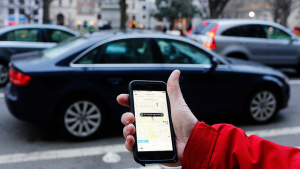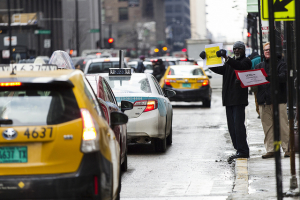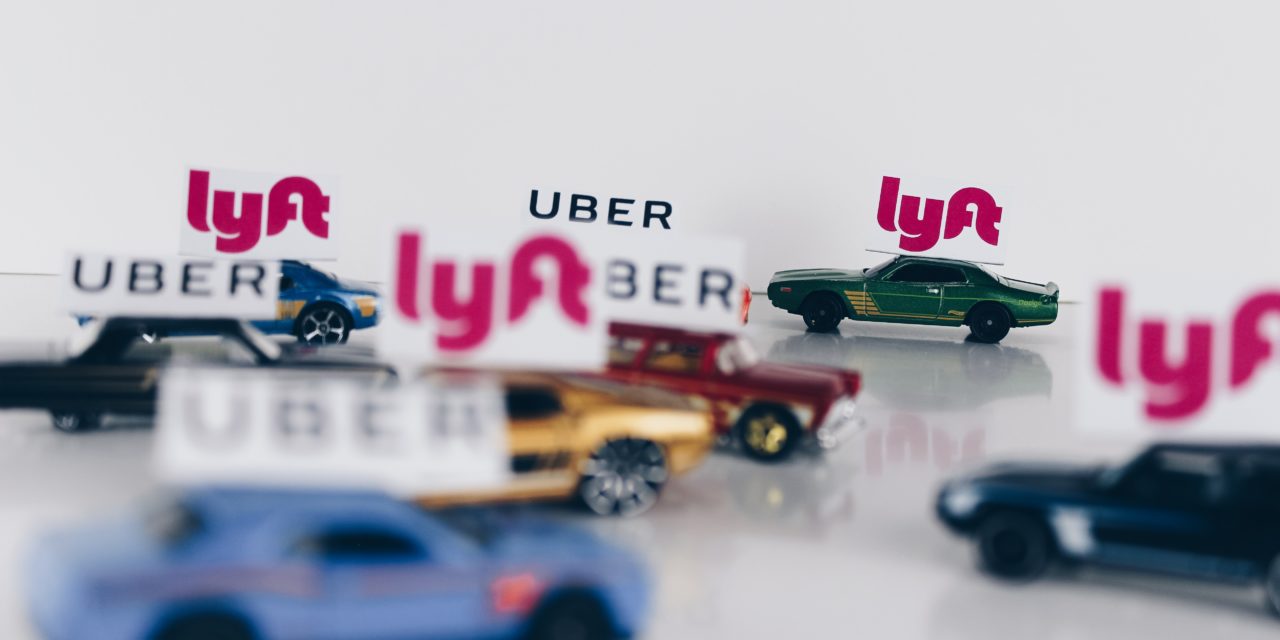In a previous post, we introduced the gig economy and discussed why it’s difficult to estimate how many people participate. In today’s post, we discuss some of the tradeoffs that workers must consider as well as some of the legal challenges and other obstacles that the platforms have faced.
What tradeoffs do workers make when participating in the gig economy?

Smartphone apps allow customers to request services and rate providers. Photo courtesy of Mark Warner, CC BY 2.0.
The gig economy grew thanks to the Internet and especially smartphones. Companies make it easy for customers to find an offering in their area, and workers like the ability to work only when they want to work. The gig economy provides workers easier entry into the market and greater flexibility in choice of projects and schedules that a typical 9-to-5 job doesn’t allow. However, traditional wage and labor laws typically don’t apply to such work arrangements, so gig workers don’t receive the benefits of full-time employees, such as health insurance, paid vacation and sick leave, and overtime pay.
Companies in the gig economy don’t let just anyone work for them. While many of these platforms attract a wide variety of workers of different ages, backgrounds, and levels of experience, some requirements usually must be met during the signup process. In addition, customers are encouraged to leave ratings and comments. Bad comments and ratings could cause a worker to be deactivated (prevented from accepting any more work on the platform).
Because people in diverse situations choose to work in the gig economy for different reasons, they likely value these tradeoffs differently. A college student or someone who has another job may value the chance to earn extra money and gain new skills and experience while maintaining maximum scheduling flexibility, whereas someone with a family and a mortgage and no other source of income may be struggling to make ends meet and have difficulty coping with the lack of benefits. Some retirees have noted that they see working for Uber and others as a way to stay active and social, supplement their retirement income, pay for a vacation, or save a bit more money. Unlike younger drivers, older workers may not be as concerned about benefits such as health insurance, thanks to Medicare and other benefits they earned from previous jobs.

Car collision. Photo courtesy of Wikimedia Commons user Zaphraud, CC BY-SA 2.0.
Insurance coverage is another important consideration. Commercial insurance is expensive, and personal auto insurance typically excludes coverage for business use. Many drivers using services such as Uber or Lyft (sometimes referred to as transportation network companies or TNCs) have discovered that they do not have adequate coverage in case of an accident, or their personal auto insurance policy may be canceled if their insurance company discovers that they have been driving for a TNC. Fortunately, some insurance companies have started to offer special hybrid policies or ride-sharing riders for an additional premium, but it will be a while before the industry has standardized these practices.
What challenges have gig economy platforms been facing?
Service providers in the gig economy sometimes find themselves subject to fines, legal challenges, or other penalties because they do not operate in compliance with existing business regulations. For example, Uber drivers operating around Newark Airport and Newark Penn Station in New Jersey will soon be subject to towing and face civil and criminal penalties for violating the city’s taxicab ordinance.
In addition, many of the gig economy platforms have been facing legal challenges regarding their wage and labor practices, including lawsuits and regulatory changes. In December 2015, drivers in Seattle were given the right to unionize and collectively bargain after a successful vote by the city council, but the new ordinance may create more uncertainties than it resolves. Uber is also facing a class action lawsuit by drivers in California, who allege that because Uber controls their pay rates and performance standards, they are entitled to full-time employee benefits. Lyft experienced a similar challenge, but that class was not certified because of Lyft’s arbitration suit. Lyft offered to settle with drivers for more than $12.2 million in compensation, award some benefits, and let drivers know before they are deactivated, but the company will not have to classify drivers as employees. The U.S. District Judge still must approve the deal, and a preliminary approval hearing is scheduled for February 18.
If the lawsuit against Uber is successful, the company could be on the hook for much more than its competitor was. That’s partly because it’s a larger company than Lyft, and partly because Uber’s arbitration agreement was ruled unenforceable and the drivers have been certified as a class. The lawsuit will be heard in June, but legislators across the country are already taking a closer look at the gig economy and the companies who are revolutionizing how businesses operate.

Taxi drivers protesting Uber. Photo courtesy of Scott L, CC BY-SA 2.0.
Whatever the actual number of workers in the gig economy, one thing is clear: they are not being treated the same as other workers. Benefits such as tax withholding, minimum wage requirements, workers’ compensation for injuries, and unemployment insurance are not included in the perks of the of the gig economy such as flexible schedules and ease of finding clients. What remains to be determined is whether government intervention with increased regulation would be an improvement, or if the market should be allowed to sort itself out.






Recent Comments